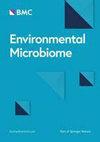无雪和有(亚)雪覆盖的高山 Pinus cembra 森林土壤中的真菌和细菌群落及其联系
IF 6.2
2区 环境科学与生态学
Q1 GENETICS & HEREDITY
引用次数: 0
摘要
在欧洲,欧洲赤松(Pinus cembra)森林覆盖了亚高山和高山地区,具有很高的保护和生态意义。这些森林的季节性很强,无雪期和积雪覆盖期交替出现。虽然鹤望兰因菌根作用而闻名,而且菌根通常涉及真菌、植物和细菌,但人们对(亚)高山鹤望兰森林中真菌和细菌的群落组成及其关联的研究仍远远不够。在这里,我们研究了三片独立的(亚)高山P. cembra森林中的真菌和细菌群落组成,并利用标记基因测序和网络分析推断了它们之间的微生物关联。我们询问了积雪覆盖对微生物组成和关联的影响。此外,我们还提出了通过一系列筛选标准来推断微生物关联的方法,并在此基础上推断出了有充分理由的、具体的、具有高度生态相关性的微生物关联,这些关联在 P. cembra 森林中具有典型性,并取决于积雪覆盖情况。在森林地点和积雪覆盖率方面,真菌和细菌群落的整体结构具有可比性。但是,在无雪和有雪覆盖的土壤中,一些典型的 P. cembra 森林微生物类群(如 Russula、Tetracladium 和 Phenoliphera)的出现、丰度和多样性模式有所不同。此外,网络特性和微生物关联也受积雪覆盖的影响。在这里,我们介绍了在整个微生物网络中反复发现的属和种级别的具体微生物关联,从而证实了它们的生态相关性。最重要的是,外生菌根真菌(如Basidioascus、Pseudotomentella和Rhizopogon)以及吸液菌Mortierella会根据积雪覆盖情况改变它们的细菌关联伙伴。这是首次在几种(亚)高山P. cembra森林中研究真菌与细菌的关联。积雪覆盖对土壤真菌和细菌(尤其是那些与 P. cembra 根部有菌根关系的真菌和细菌)以及无菌土壤生物的影响鲜有研究,这凸显了森林季节性的相关性。我们的研究结果突出表明,积雪覆盖的季节性影响对生态系统的生态有重大影响,特别是在菌根化和养分循环方面。为了全面了解生态系统的功能恢复能力和反应能力,必须考虑这些影响。本文章由计算机程序翻译,如有差异,请以英文原文为准。
Fungal and bacterial communities and their associations in snow-free and snow covered (sub-)alpine Pinus cembra forest soils
In Europe, Pinus cembra forests cover subalpine and alpine areas and they are of high conservational and ecological relevance. These forests experience strong seasonality with alternating snow-free and snow covered periods. Although P. cembra is known for mycorrhization and mycorrhizae usually involve fungi, plants and bacteria, the community compositions of fungi and bacteria and their associations in (sub-)alpine P. cembra forests remain vastly understudied. Here, we studied the fungal and bacterial community compositions in three independent (sub-)alpine P. cembra forests and inferred their microbial associations using marker gene sequencing and network analysis. We asked about the effect of snow cover on microbial compositions and associations. In addition, we propose inferring microbial associations across a range of filtering criteria, based on which we infer well justified, concrete microbial associations with high potential for ecological relevance that are typical for P. cembra forests and depending on snow cover. The overall fungal and bacterial community structure was comparable with regards to both forest locations and snow cover. However, occurrence, abundance, and diversity patterns of several microbial taxa typical for P. cembra forests differed among snow-free and snow covered soils, e.g. Russula, Tetracladium and Phenoliphera. Moreover, network properties and microbial associations were influenced by snow cover. Here, we present concrete microbial associations on genus and species level that were repeatedly found across microbial networks, thereby confirming their ecological relevance. Most importantly, ectomycorrhizal fungi, such as Basidioascus, Pseudotomentella and Rhizopogon, as well as saprobic Mortierella changed their bacterial association partners depending on snow cover. This is the first study researching fungal-bacterial associations across several (sub-)alpine P. cembra forests. The poorly investigated influence of snow cover on soil fungi and bacteria, especially those mycorrhizing P. cembra roots, but also saprobic soil organisms, underlines the relevance of forest seasonality. Our findings highlight that the seasonal impact of snow cover has significant consequences for the ecology of the ecosystem, particularly in relation to mycorrhization and nutrient cycling. It is imperative to consider such effects for a comprehensive understanding of the functioning resilience and responsiveness of an ecosystem.
求助全文
通过发布文献求助,成功后即可免费获取论文全文。
去求助
来源期刊

Environmental Microbiome
Immunology and Microbiology-Microbiology
CiteScore
7.40
自引率
2.50%
发文量
55
审稿时长
13 weeks
期刊介绍:
Microorganisms, omnipresent across Earth's diverse environments, play a crucial role in adapting to external changes, influencing Earth's systems and cycles, and contributing significantly to agricultural practices. Through applied microbiology, they offer solutions to various everyday needs. Environmental Microbiome recognizes the universal presence and significance of microorganisms, inviting submissions that explore the diverse facets of environmental and applied microbiological research.
 求助内容:
求助内容: 应助结果提醒方式:
应助结果提醒方式:


